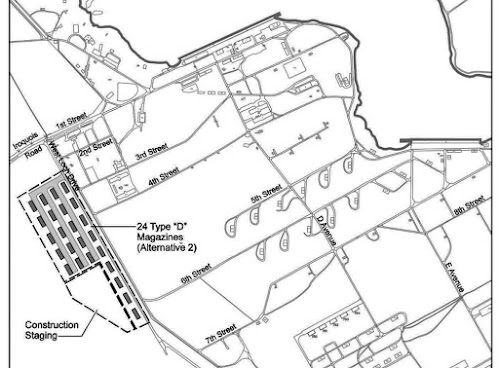Compiled History by Ewa Historian John Bond
West Loch ESQD (safety arc blast zone) Revealed from a Recently Published 2017 Public Document
For the first time the West Loch Blast Zone ESQD has been found. The Navy in Hawaii has never released this map before. All maps shown and documents used here are from US government publications, project analysis and environmental assessments, and are NOT secret or disclosing anything to China and Russia which actually know a lot more about all this than does the local West Oahu community. The communities near these munitions sites deserve to know this information because all this could have a large impact on home construction, building codes, schools, insurance, evacuations, emergency response and much, much more. This was extensively revealed in the 2018 MOTSU disclosures to the communities near it in North Carolina.
The MOTSU Blast Zone Arc is approximately 3.5 miles or MORE
The Navy in Hawaii disclosed the West Loch ESQD in 2003 in an unpublished report. The Navy very often keeps important community information in unpublished reports documents. Sometimes these documents can be found using a FOIA process (Freedom of Information Act.) However the West Loch blast zone safety arc of 2003 was revealed and can be found in this university thesis: Cost of Compliance on Graduate School of Business & Public Policy Thesis, December 2017, Naval Postgraduate School, Munitions Consolidation from Lualualei to West Loch. This is a US government document and can be seen and downloaded online.
https://calhoun.nps.edu/handle/10945/58904
The thesis is a rationale for moving Army munitions to West Loch and consolidating them all with new Navy Type D storage units that will be built for missiles. In the analysis a number of significant new maps were revealed for the first time in a public document.
The Navy 2003 blast zone arc map has been annotated in red to show the public what is currently there and what is planned to go in soon. None of this is classified information and details can be found in public documents on the internet. The Navy policy concerning “special weapons-AKA nukes” is that they will neither “confirm nor deny” that nuclear weapons are stored in a specific location. The obvious indicator most used is to look for a double high security fence around the site. Waikele was once also a known site for storing nuclear weapons and had very high security and double fencing. Today it is generally known that intercontinental ballistic missiles for Navy submarines are stored and loaded in a remote area in Bangor, Washington. There isn't a "boomer" missile submarine loading facility in Pearl Harbor at this time.
https://www.globalsecurity.org/military/facility/lualualei.htm
Global Security: Naval Magazine, Lualualei May 2011 stated this about nuclear weapons: In January 2000 the designation Naval Magazine, Lualualei, Hawaii, was changed to Naval Magazine Pearl Harbor. The name change was a result of the command's recent headquarters move from the Lualualei Branch to Pearl Harbor's West Loch. Fifty W-80-0 munitions for Tomahawk SLCM's and 40 nuclear aerial bombs are stored in the Lualualei Naval Magazine (NAVMAG) at West Loch on Oahu, Hawaii.
Supposedly according to treaties with Russia, Navy attack submarines do not carry nuclear Tomahawks. However, all of this is now changing as all the key treaties are being cancelled to allow a wide range of new nuclear weapons of many types and sizes. The nuclear aerial bombs that possibly are now stored in West Loch are most likely the B-61 type which are generally considered outdated for use against a sophisticated air defense system like Russia or China. The big weapons trend is going to “stand off” missiles.
https://en.wikipedia.org/wiki/B61_nuclear_bomb
The B61 nuclear bomb is the primary thermonuclear gravity bomb in the United States Enduring Stockpile following the end of the Cold War. It is a low to intermediate-yield strategic and tactical nuclear weapon featuring a two-stage radiation implosion design.
The B61 is of the variable yield ("dial-a-yield" in informal military jargon) design with a yield of 0.3 to 340 kilotons in its various mods. It has a streamlined casing capable of withstanding supersonic flight speeds, is 11 ft 8 in (3.56 m) long, with a diameter of about 13 inches (33 cm). Basic weight is about 700 pounds (320 kg), although the weights of individual weapons may vary depending on version and fuze/retardation configuration. As of 2020, it is undergoing a 12th modification. According to the Federation of American Scientists in 2012, the roughly 400 B61-12s will cost $28 million apiece.






